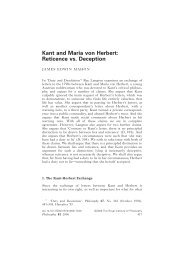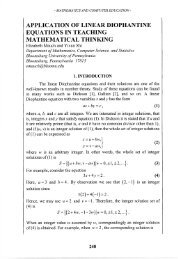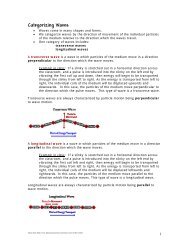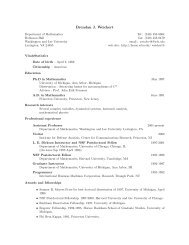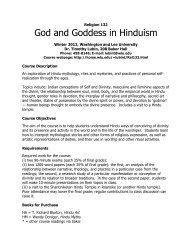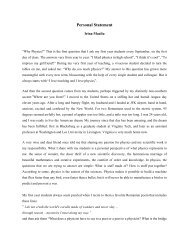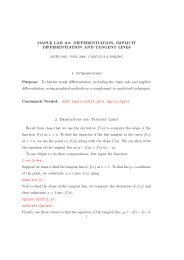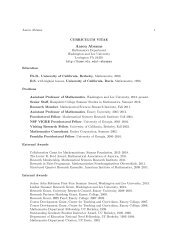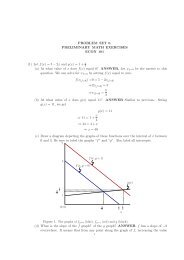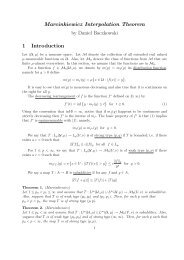Three Transcendental Numbers from the Last Non-Zero Digits of nn ...
Three Transcendental Numbers from the Last Non-Zero Digits of nn ...
Three Transcendental Numbers from the Last Non-Zero Digits of nn ...
Create successful ePaper yourself
Turn your PDF publications into a flip-book with our unique Google optimized e-Paper software.
Integre Technical Publishing Co., Inc. Ma<strong>the</strong>matics Magazine 81:2 December 19, 2007 8:47 a.m. dresden.tex page 99<br />
VOL. 81, NO. 2, APRIL 2008 99<br />
tenth nonzero digit (which will be left alone). This means that each A n has nonzero<br />
digits only every 10 n th place, at 10 −10n , 10 −2·10n , 10 −3·10n , and so on. Visually, this<br />
sequence looks like <strong>the</strong> following, where <strong>the</strong> dots represent zeros.<br />
A 0 = 0.1476563691 1636567496 1476563699 1636567496 ···<br />
A 1 = 0..........1 .........6 .........9 .........6 ···<br />
A 2 = 0........... .......... .......... .......... ···<br />
(The number A 2 doesn’t have a nonzero digit until <strong>the</strong> one hundredth decimal place, at<br />
10 −100 .) If we remove <strong>the</strong> dots and condense <strong>the</strong>se decimals a bit, we see an interesting<br />
pattern develop (recall that <strong>the</strong> nonzero digits in A n are actually 10 n decimal places<br />
apart; think <strong>of</strong> <strong>the</strong> spaces in A 1 , A 2 , etc. as representing lots and lots <strong>of</strong> zeros)<br />
A 0 = 0.1476563691 ···<br />
A 1 = 0. 1 6 9 6 5 6 9 6 1 1 ···<br />
A 2 = 0. 1 6 1 6 5 6 1 6 1 1 ···<br />
A 3 = 0. 1 6 1 6 5 6 1 6 1 1 ···<br />
A simple application <strong>of</strong> [4, Lemma 3] shows that for n ≥ 2, <strong>the</strong> sequences <strong>of</strong> nonzero<br />
digits in each A n are identical: 1, 6, 1, 6, 5, 6, 1, 6, 1, ∗, where ∗ is ei<strong>the</strong>r 1, 6, or 5<br />
depending on <strong>the</strong> position. This implies that R n = A n − A n+1 is rational for n ≥ 2;<br />
<strong>the</strong> cases n = 0 and n = 1 follow immediately <strong>from</strong> Lemma 2 below. Since each R n is<br />
rational, <strong>the</strong>n if we can show that A n is well approximated by rationals (in <strong>the</strong> context<br />
<strong>of</strong> <strong>the</strong> Thue-Siegel-Roth <strong>the</strong>orem), this might help us to approximate A as well. Let’s<br />
investigate <strong>the</strong>se A n ’s a bit fur<strong>the</strong>r.<br />
If we write out just <strong>the</strong> nonzero digits <strong>of</strong> A n (with appropriate spacing)<br />
A n = 0. 1 6 1 6 5 6 1 6 1 1 ··· (for n ≥ 2)<br />
we clearly see that each A n (for n ≥ 2) is quite close to <strong>the</strong> rational number<br />
s n<br />
t n<br />
= 0. 1 6 1 6 1 6 1 6 1 6 ···<br />
Here, just as with A n , <strong>the</strong>se nonzero digits <strong>of</strong> s n /t n are actually 10 n decimal places<br />
apart. Thus, s n /t n is easily seen to be 1·1010n +6<br />
. Also, it is easy to see that A 10 2·10n −1<br />
n and s n /t n<br />
differ in <strong>the</strong> fifth visible position (among o<strong>the</strong>r places), which means that <strong>the</strong>y differ<br />
by about<br />
5·10n<br />
. As a result, we have<br />
4<br />
10<br />
∣ A n − s ∣<br />
n ∣∣∣<br />
≈ 4 <<br />
t n 10 5·10n<br />
1<br />
≈ 1<br />
10 4.2·10n t<br />
2.1 n<br />
(The attentive reader will notice that we could have easily replaced <strong>the</strong> 2.1 with 2.4 or<br />
even 2.49. However, 2.1 will work fine for our purposes.)<br />
Let’s now relate this back to A. Recall that we have A n+1 = A n − R n , and it is<br />
easy to show that <strong>the</strong> rational number R n has denominator 10 10n+1 − 1 for n > 0 and<br />
denominator 10 20 − 1 at n = 0. We define p n /q n as<br />
p n<br />
q n<br />
=<br />
(<br />
n−1 ∑<br />
i=0<br />
R i<br />
)<br />
+ s n<br />
t n<br />
.<br />
The denominator q n is 10 2·10n , <strong>the</strong> same as t n , because <strong>the</strong> denominator <strong>of</strong> each R i<br />
divides evenly into t n . Thus,



